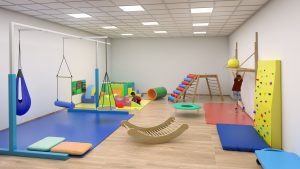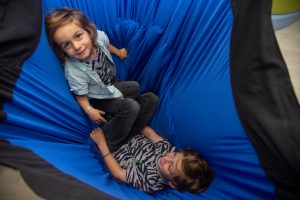Nair Alcocer
Occupational Therapist. Specialist in the Use of Augmentative and Alternative Systems for Language and Communication. Expert in Sensory Integration.
Read more posts
Let’s talk about sensory integration… We know that thanks to our senses, we receive information from the world and from ourselves, which provides crucial information for our brain to process. Our brain then comes up with a response to the situation at hand. For example, if someone shines a very bright light in our eyes, the brain sends a signal through the nervous system so our pupils constrict. This is a protection mechanism to control the amount of light entering the eye. Conversely, if we enter a dark room, our pupils dilate to help more light enter the eye. The visual information is what starts this chain reaction.
Likewise, the brain makes decisions to help us keep safe, keep our body regulated and interpret the action and emotions of others, to name just a few. But things are not so simple… There needs to be a fine balance in this whole process. If we were totally conscious of all the auditory stimuli in our environment, or received unregulated tactile stimuli, we would feel totally overwhelmed! The right sensory processing is necessary for things to make sense.
Sensory Integration is the neurological process by which we organize the data we are receive, we interpret it and give adaptive responses to the situations that are presented to us. Our brains conduct sensory integration without us even being aware of it, this process is key for emotional, cognitive, motor and communicative development.

Jean Ayres, therapist and psychologist, investigated this process and its alterations, creating the theory of sensory integration as it is now used in the practice of occupational therapy and applied in early care and early childhood education. The Ayres intervention process (Ayres Sensory Integration®, ASI) is often focused on game and includes careful use of vestibular, proprioceptive, and tactile sensory input to help the child develop a foundation of ordered sensory processing on which functional skills can be built.
In fact, sensory integration is one of the pillars of motor development, language, motor planning, and emotional well being, so if SI is not adequate this will interfere in development.
The intervention is mainly focused on the following systems: touch (informs us of the body limit), proprioceptive (tells us how the parts of our body are positioned), and vestibular (tells us how our head moves in space). These systems are interconnected and key in the interpretation and response of environmental stimuli. These systems also help us to carry out many daily life activities. Without its proper functioning we could not write, read fluently, sit in class and know where the sound comes from when the teacher calls us, learn new ways to move (to play a sport, ride a bike, …), etc. . That is why ultimately, sensory integration therapy seeks to improve functionality and autonomy.

The vestibular system provides us with information about where our body is in relation to space. It is responsible for letting us know whether our body is motionless or moving, also speed and direction of movement.
It is a fundamental element of the central nervous system, and essential for the development of balance, coordination, fine motor skills, bilateral coordination, self-regulation, and all the motion related aspects.
People with problems associated with this processing may find everyday activities really challenging., also may find issues when moving responding to the environment . For example, a child with vestibular issues might not be able to judge space correctly and therefore decide to jump from a high surface. The child may not even realize he is going to land on the ground and can get hurt, and he could eventually lose confidence too.

One of the key elements for sensory integration intervention is the Snuggle Bag, a suspended equipment in a sensory integration room. This cosy bag embraces and surrounds the user putting him in a fetal position, which allows swinging and rocking, being optimal for those who are hypersensitive to movement since the therapist can start still and then swing progressively; as well as for those who are hyposensitive and need more stimuli. It helps with emotional regulation providing users with a great sense of security and calm.
In a guided environment you can use swings or suspended equipment that allow a full range of movement: varied positions, turn from side to side, rocking, vertical stimulation, etc. If, on the contrary, the sensation of movement scares the user, this same equipment allows us to gradually and playfully approach the user so that he begins to feel safe when moving.
It provides multiple benefits for the vestibular area; and it is optimal for use at home, hospitals, kindergartens, schools, as well as sensory rooms.
See more details about the Snuggle Bag here.
Occupational Therapist. Specialist in the Use of Augmentative and Alternative Systems for Language and Communication. Expert in Sensory Integration.
Read more posts